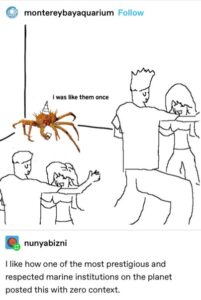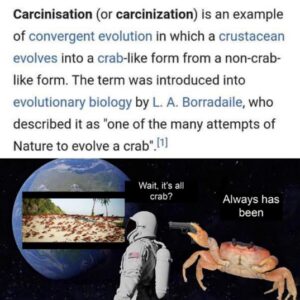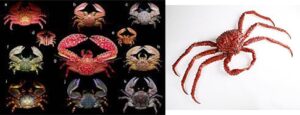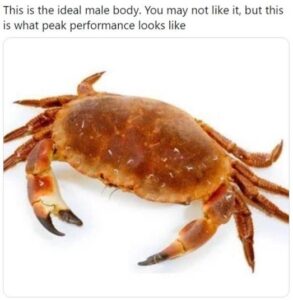Evolution is a very complicated field – and one of the bigger long-standing questions is crabs! Specifically, why animals keep evolving into them!
The phenomenon of animals, or specifically crustaceans, evolving into a crab-like shape has occurred so often it has a name: carcinization. The term was coined way back in 1916, by evolutionary biologist Lancelot Borradaile, and today it has risen back into public vocabulary through the power…of memes.
“Either die a hero, or live long enough to become crab”
But memes aside, this phenomenon raises several questions:
Question 1: What is a crab?

Crabs – the animals we call crabs at least – are all a part of the evolutionary order Decapoda (meaning literally “ten feet”), under the phylum Arthropoda, subphylum Crustacea, and clade Meiura (Kazlev, 2022). “True crabs” all fall under the infraorder Brachyura. They include species such as the Japanese spider crab, blue land crabs, ghost crabs, snow crabs, etc., and can be most easily differentiated by having 4 pairs of walking legs.
Question 2: What is not a crab?
Or at least, who are the fakes?
“False crabs” are largely on the neighboring Anomura branch – hermit crabs, porcelain crabs, coconut crab, king crabs even, are all false crabs. They tend to have 3 visible pairs of walking legs, with the 4th pair often smaller or hidden under their shell.
To put it shortly, these are crabs:
These are not:
Get it? Nope
Question 3: How does one become a crab?
The process of carcinization is characterized by the crustacean’s carapace becoming flat and wide, while it’s abdomen or “pleon” shorten and curves underneath. The appendages that would normally form the tail of a lobster either shrink or disappear. Additionally, the plates that make of the underside, or ventral, part of the animal’s shell become fused into one. It’s important to note too, that not all these steps have to occur – many undergo “partial” carcinization, such as the hermit crab, who keeps their tail (Wolfe et al., 2021).
Final question: Why?
Why become a crab? Potentially, the crab form provides more protection and, surprisingly, flexibility for crustaceans (Green, 2020). With the pleon tucked under the carapace, there’s less surface area for predators to grab; and with a more compact body, crabs can scuttle around pretty quickly. They can get into smaller cracks than their more lobster-like compatriots.
Why are scientists studying this? Right now, carcinization serves as a frequent and recognizable pattern of evolution – AKA convergent evolution, where animals of a similar niche evolve similar features. For evolutionary biologists, this provides a potential wealth of data for seeing trends in how several species evolved, and predicting how even more may evolve in the future. Additionally, as noted by Wolfe et al., the fact that the widening of the carapace and curling of the abdomen evolves together so frequently implies that the two phenotypes may be linked developmentally, or even genetically!
Why is this a meme???
To be frank, this quirk of evolution is just…funny! Crabs are such a random, funky little animal – they alone are a sort of meme! So when people find out that this strange little creature, for some reason, keeps popping up in nature, it surprises them. Not only does a seemingly random process like evolution apparently have a pattern – the pattern is crabs; and it’s happened so often that there’s a name for it!
So in short:
C_Mill24. (2022, October 20). Carcinization. Know Your Meme. https://knowyourmeme.com/memes/carcinization
Green, H. (2020). Why Do Things Keep Evolving Into Crabs? PBS Eons. YouTube. https://www.youtube.com/watch?v=wvfR3XLXPvw.
Kazlev, M. A. (n.d.). Decapoda: Anomura. Palaeos Arthropods: Crustacea: Decapoda: Meiura. http://palaeos.com/metazoa/arthropoda/decapoda/meiura.html
Wikimedia Foundation. (2022, November 20). Carcinisation. Wikipedia. https://en.wikipedia.org/wiki/Carcinisation#:~:text=Carcinisation%20(or%20carcinization)%20is%20an,Nature%20to%20evolve%20a%20crab%22.
Wolfe, J. M., Luque, J., & Bracken‐Grissom, H. D. (2021). How to become a crab: Phenotypic constraints on a recurring body plan. BioEssays, 43(5), 2100020. https://doi.org/10.1002/bies.202100020







